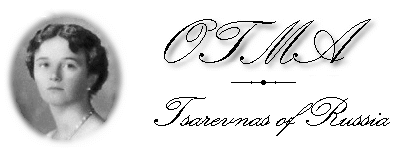
There they lie,
Mementos of innocence and girlhood.
Plundered by guards, scrutinized by investigators.
They are history's daughters.
Of all the royal sisters in the world,
the daughters of Nicholas II were probably the closest. Born at almost exact
two-year intervals, the four grand duchesses almost instantaneously bonded. Olga -
the eldest, a snub-nosed chestnut blond with blue eyes and a fiery temper; Tatiana - a
tall, statuesque, delicate grey-eyed beauty who was blessed with the gift of tact; Maria -
'the fat bow wow,' the typical middle child, good-hearted and clumsy; and Anastasia - a
mischievous child with twinkling blue eyes and a cutting wit. In physical
characteristics they were almost identical: today, it takes a knowledgeable eye to tell
the difference between them in black-and-white photographs. In character, they were
also analogous: taught to be patient, regal, and gentle, they made a team. As
adolescents, they decided on a composite Christian name, OTMA, formed from the first
letter of each of their names. Through this acronym they jointly signed notes,
gifts, and letters to their parents and friends.
Close they were, but also completely different.
In fact, it is surprising to see how well they worked together. Olga had a
temper, which she early learned to keep under control, but she was the most difficult of
the four - challenged only by Anastasia, who preferred to exert her temper
through pranks - and often talked back to her mother. She and Tatiana - a patient,
tactful, but decisive girl - formed the 'Big Pair,' while Maria and Anastasia made up the
'Little Pair.' The 'Big Pair' and 'Little Pair' confided in each other, and
frequently brought these confidences over to the other pair. Likewise, Maria was
passive and agreeable, and the more domineering Anastasia quickly dragged Maria into her
numerous brainstorms. And while their clothes may have looked the same, each grand
duchess had an imperceptible, unique cut in their dress, or a special ribbon.
 Perhaps one reason why OTMA Nikolaievna were so dear to one another is
that their mother kept them cloistered from other children their age. Fearful of the
detrimental Russian aristocracy's effects on her children, the Tsaritsa preferred to keep
her daughters' minds clear. Her desire - a worthy one - was not to breed arrogant
princesses, but practical, clear-minded women. However, she strained the boundaries,
effectively cutting her children off from most 'decadent' society. The Empress
succeeded, but at a cost: OTMA were now secluded completely in a fairy-tale world.
They rarely went to social functions, and then only if their parents were required to
attend. For the most part, although they were allowed to see cousins and make
friends of the servants, Olga, Tatiana, Maria, and Anastasia's best friends were
themselves. When they reached their teenage years, they formed a composite Christian
name, "OTMA," composed of the first initial of each girl's name. As OTMA,
they jointly signed notes, cards, and gifts.
Perhaps one reason why OTMA Nikolaievna were so dear to one another is
that their mother kept them cloistered from other children their age. Fearful of the
detrimental Russian aristocracy's effects on her children, the Tsaritsa preferred to keep
her daughters' minds clear. Her desire - a worthy one - was not to breed arrogant
princesses, but practical, clear-minded women. However, she strained the boundaries,
effectively cutting her children off from most 'decadent' society. The Empress
succeeded, but at a cost: OTMA were now secluded completely in a fairy-tale world.
They rarely went to social functions, and then only if their parents were required to
attend. For the most part, although they were allowed to see cousins and make
friends of the servants, Olga, Tatiana, Maria, and Anastasia's best friends were
themselves. When they reached their teenage years, they formed a composite Christian
name, "OTMA," composed of the first initial of each girl's name. As OTMA,
they jointly signed notes, cards, and gifts.
But they remained perfectly pure - albeit at a cost - and they did
not know anything much of life "beyond the palace gates." They were happy
and content to remain in the palaces, playing and talking like any other girls. In a
way their growth was stunted. Because of their seclusion, the two eldest did not
mature as quickly, often bringing the hasty decision by some court official: "They
are eighteen, but they talk as if they were twelve!" Nevertheless, all were
inquisitive, and had remarkably sharp minds.
Olga, naturally withdrawn, did not wish terribly for a typical court
life. She wanted "good friends," though - normal friends that she could
share thoughts and complaints and confidences with, without a host of police following
them around. As she and Tatiana grew older, they began to long for friends outside
their circle.
Tatiana was a social butterfly. She had the mind and the
desire - sometimes - to ponder great issues, but unlike Olga, who could spend eight hours
a day in a reclusive state, she preferred parties and balls. In 1913, she hit her
sixteenth birthday - and immediately soared out into court life, delighted at her newfound
freedom. Unfortunately, she did not enjoy it for long. In 1914, World War I
began, and all social functions were, for all practical purposes, removed from Russian
language.
Maria and Anastasia were naturally generous and soft-hearted, like
their older sisters. But while Maria was 'an angel and the best of us,' Anastasia
used her wits to plead out of bad school papers, plot practical jokes on some poor soul,
or make her family laugh by imitating the fat Countess who was afraid of mice.
All four girls dressed alike: white lace gowns with colored sashes
for the year round; warm yet tasteful coats and hats for the winter months; neat sailor
suits for spring; flowing white dresses, plain blouses, and simple dark skirts for summer.
As the grand duchesses grew towards adolescence, Olga and Tatiana began to be
permitted to choose their own clothing. They chose simple Edwardian English styles,
after their mother's tastes, and the two eldest coordinated their clothes.
Alexandra had inherited a sense of duty to charity from her mother,
who sponsored her own school in Darmstadt and passed on this charitable attitude to her
children. Olga, Tatiana, Maria, and Anastasia were all sensitive to others' needs,
and as little children, even, sewed clothes for soldiers at war with Japan (the
Russo-Japanese war, 1904-5). The childrens' nurse, M. Eagar, recalled the little
tsarevnas diligently sewing away, scrunching up the waist of large pants to fit them into
small waistbands. Early on they learned to knit and embroider, as well as other fine
arts: French and piano. Olga, when she began receiving a small allowance at the age
of eighteen, immediately began donating to various charities. There are several
touching photographs of the grand duchesses with some little peasant children.
Heading back from a short vacation in 1916, the imperial train stopped near the
shack-like house of a family. Quite natural, pleasant, and humble, they show an
almost exact opposite from the attitude of the aristocracy in the early 1900s.
In 1914, Russia declared war on Germany. Olga and Tatiana
quickly began studying, and passed their nurses' exams with flying colors, together with
Alexandra and her friend Anna Viroubova. They wore their Red Cross uniforms with
pride, and many a soldier remembered their patience and kindness. Maria and
Anastasia, while too young to become nurses, sponsored their own hospital on the grounds
of Tsarskoe Selo. They would visit the soldiers, some of whom told stories "of
a very questionable nature," according to Anna Viroubova, and would joke around with
them.
In the very early months of 1917, the grand duchesses began falling
ill with measles. As the Revolution raged around them, they were kept in darkened
rooms, with their heads shaved - according to the "cures" of the time. One
of Tatiana's eardrums ruptured, causing her to become temporarily deaf. It had to be
written down for her that their father had relinquished the throne.
But the revolution and their subsequent house arrest in the
Alexander Palace did not mar their  spirits.
Together with their father, brother, and servants, they helped dig a little garden
in Tsarskoe Selo, plant vegetables, and tend to them, as their mother looked on. To
conceal their shaven heads - with the hair barely beginning to grow back - they
occasionally resorted to wigs, but more often, to hats and scarves. So it was with
great shock that Pierre Gilliard posed them for a portrait - only to discover that, on
Olga's signal, they had removed their hats and posed bald! They made friends with a
few of the Provisional Government guards, and even took photographs with them.
spirits.
Together with their father, brother, and servants, they helped dig a little garden
in Tsarskoe Selo, plant vegetables, and tend to them, as their mother looked on. To
conceal their shaven heads - with the hair barely beginning to grow back - they
occasionally resorted to wigs, but more often, to hats and scarves. So it was with
great shock that Pierre Gilliard posed them for a portrait - only to discover that, on
Olga's signal, they had removed their hats and posed bald! They made friends with a
few of the Provisional Government guards, and even took photographs with them.
When the family was moved to Tobolsk, the "former" grand
duchesses found it harder than their familiar Tsarskoe Selo, but they enjoyed the large
yard, the wooden swing, and their lessons - German and English, among other things.
The guards were more offensive, but they were still friendly. And Gleb Botkin
recalled that his father (imperial physician Dr. Botkin, who had gone with them to Tobolsk
and died with the family in Ekaterinburg) would sometimes tell him about the days when the
girls would whisper to each other to be cheerful, because Mama was depressed.
They were split apart for a short while, in early 1918, when
Nicholas, Alexandra, and Maria were moved to Ekaterinburg, another Siberian town.
Tatiana, "The Governess," retained command of the household - over Olga, who
suffered from ennui (she had already finished all her lessons years before, so there was
little else to do), Anastasia, and sickly Alexei. During this period, all wore
corsets sewn with jewels. In order to protect the precious Romanov jewelry, they
sewed it into their clothing, into the linings of hats and coats.
Their last journey was made on board the ship Rus, down the
Tyumen River to Ekaterinburg, in early 1918. They met their family at the
"House of Special Purpose" - the Ipatiev House.
Olga's twenty-second birthday had been passed in November, in
Tobolsk. Nicholas and Alexandra celebrated their birthdays in Ekaterinburg; then
came Tatiana's (21), Anastasia's (17), and Maria's (19). The last was on the 26th of
June, according to the "New Style" calendar.
Exactly twenty-one days later, in the first hours of July 17, 1918,
they disappeared from history - murdered. Four innocent, blooming young girls, cut
down simply for being the daughters of a tsar!

Clockwise from bottom right: Alexei, Anastasia,
Tatiana, & Olga.
This photograph, perhaps the last of 4 of the 5 children together,
was taken in early 1918, in Tobolsk.

Home ~ Nicholas ~
Alexandra ~
OTMA ~
Alexei
Photo Album ~
Poetry ~
Links ~
Books ~
Credits ~
Grandanor Society
Webring
~ Updates
~ Awards
~ FAQ ~
Romanov Family
Anastasia:
The Movie ~ Anastasia FAQ

© 1998-2001 Victoria Bostwell
All rights reserved